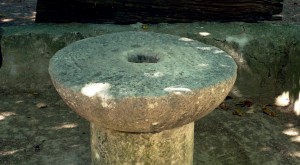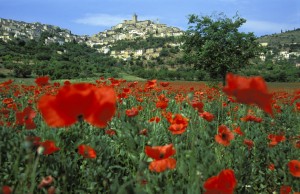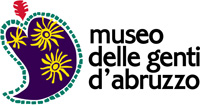Our roots
Many of our guests are surprised to read the many writings that decorate the Moorish portico of the main house. Among all, what is more surprising is an inscription of 1968, the day of the memorable discovery of proto-historic village of Madonna degli Angeli.
This is just one of many testimonies that inextricably bind this house and its land to its owners and their history.
Our family is linked to these places since the seventeenth century, when our ancestor Lorenzo de Pompeis decided to move in Torre de’ Passeri village from Castelli, a small village in the province of Teramo at the foot of Gran Sasso mountains. Here since the end of the fifteenth century, the founder of our family Orazio Pompei was dedicated to the job that was considered noble in the Renaissance: the art of majolica painting. The commissions were the most important royal and princely houses of Italy such as Aragona, the Orsini and the Farnese. for which the most important family of ceramists of the ’500 was that of “Pompei” (this was the original surname, then “de Pompeis”), in the village which still preserves its ancient building and furnace.
When, in 1.600, my ancestors moved to Torre de’ Passeri, for the position of the illuminated marquis Mazzara, as well as the natural land resources (water, clay, etc.), Lorenzo de Pompeis, after having implanted the factory, he commissioned to build an important mansion that overlooks the main square and, as was customary in those days, began to buy many lands in the surrounding area that were used for growing grapes and olive trees, typical crop of the valley floor. Among them appeared the Madonna degli Angeli, which took its name from the nearby small country church that still welcomes our guests, just before entering the farmhouse.
The de Pompeis family for centuries has maintained its privileged position, defending the Enlightenment ideals that were rooted in their origins and bourgeois merchant, ever to host in the course of history, the Carbonari, the king Gioacchino Murat and the generals Chervardes and Howard, that the historical family archives have resided in the alcove of the house.
 |
Even today coming into this building, which is bound as a National Monument for the originality of the structure, furniture and furnishings extraordinarily preserved intact, the visitor is immediately attacked by the looks of family portraits on the walls, not so much to remind the individual character but the continuity of the family who wants to witness the history of their origins
 |
And it is the continuity and the desire not to forget the “the roots” that led, by means and in different ways, all the members of this family in the years to keep up to date their history; at the same time, this attachment to traditions, inherited from the past, led us to cultivate the love for the history of our country.
 |
My father, Claudio de Pompeis, and before that my grandfather Ermanno, both doctors, “curious about man” and of its many aspects, have dedicated most of their lives to study and discover the history of Abruzzo, giving, if even in an unprofessional manner, a substantial contribution to the development of archeology and culture of Abruzzi, in particular the prehistory and protohistory. Me and my brothers lived these experiences as fantastic adventures, in which the land returned to us entire chapters of history, giving us unforgettable emotions during our breadth of experience of excavation in the voluntary sector.
I will never forget the day when, during the recess to plant the vineyard at Madonna degli Angeli, the tractor stopped and my father, completely excited and in the total misunderstanding between the wonder of the peasants, began to pull out the ground vases, ornaments of various kinds, bronze pins and needles, ornaments and objects of everyday use. It was a proto-historic village of three thousand years ago, when excavations were then conducted by the Committee Abruzzese of Prehistory and Early History, of which my father was part. Dug for days and findings were far more important than what we had hoped. For us young children that was an exceptional event: our father had found the hidden treasure …! Just below the land where our grandparents had walked for centuries!
For years the family has followed my father and his friends in a tireless volunteer, which has allowed the discovery of important archaeological sites, such as the “Cave of Pigeons” in Bolognano (important shrine with Neolithic human sacrifice, just 5 minutes from the farm), the prehistoric findings in the “Giumentina Valley” at Roccamorice (30 min. – Majella) and many tens of recovery or real archaeological excavations (of course under the aegis of the Regional Superintendent or of the University of Pisa). Many of the finds are now showed in the “Museum of the Abruzzo People” (Museo delle Genti d’Abruzzo), where my father was the founder and staunch supporter in the difficult years that followed, dark and characterized by the abandonment of culture for other values ….
As for my ancestors me too, despite having chosen to graduate in sociology in Rome, I could not deny the “curiosity about the man” and the desire to preserve and pass on the passion and attraction for the history of my country, which today, together with my family, I try to convey to our guests. The brothers more directly, both museum directors in Pescara, are bringing the “witness” of family and even my wife Caterina, graduated in Archaeology, “chose” to do the graduation dissertation on the ancient fortified settlements of the Upper Valley of Pescara (ie, for a change, the area around us).
Our house, which for millennia has been a stopping place for pilgrims and for those who traveled along the Tiburtina Valeria road, continues today as a farm to be a place of comfort and an ideal starting point to explore the Abruzzi, and walking in its park maybe his particular wine tasting, revive its ancient history.




 English
English  Italian
Italian 


